At the federal level, nine FOIA exemptions stand between you and records you want. Here’s what they are, what they mean, and what you can do about them.
Exemption 1
What it says: “Specifically authorized under criteria by an executive order to be kept secret in the interest of national defense or foreign policy and (B) are in fact properly classified to such Executive Order #12958 (3/25/03).”
What it means: Classified national defense and foreign relations information.
What it really means:
What you can do about it: Depends on how recent the docs are. If it’s anywhere near the vicinity of this decade, you’re probably out of luck. If it’s on the older side, you might have a case for a Mandatory Declassification Review. Michael Morisy has a little more background about the process in our #AppleVSFBI guide.
Exemption 2
What it says: “Related solely to the internal personnel rules and practices of an agency.”
What it means: Internal agency personnel rules and practices.
What it really means: Anything from trivial HR matters to broad details about how an agency operates day-to-day. Just compare the NSA’s list of b(2) uses:
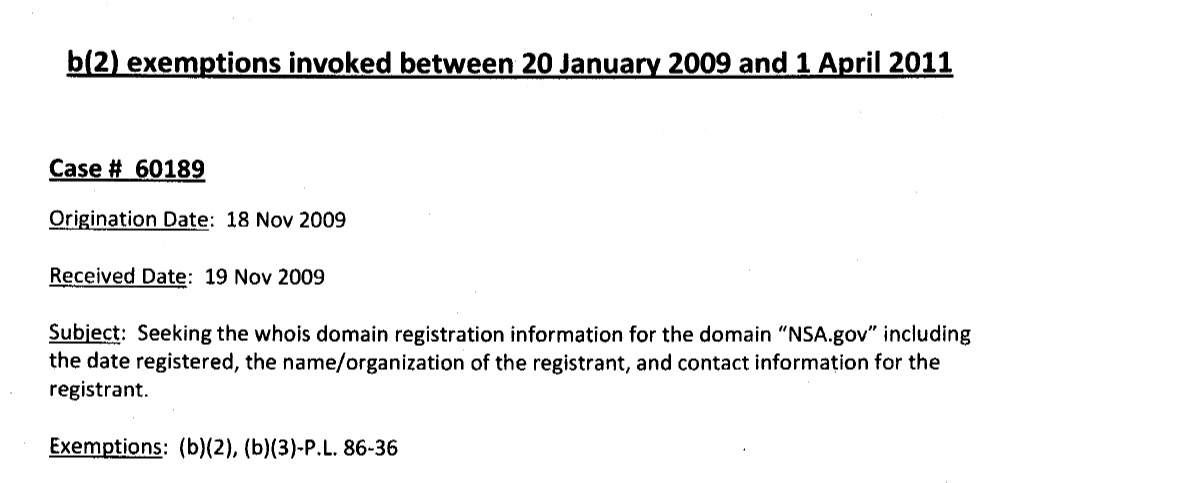
with the State Department’s …
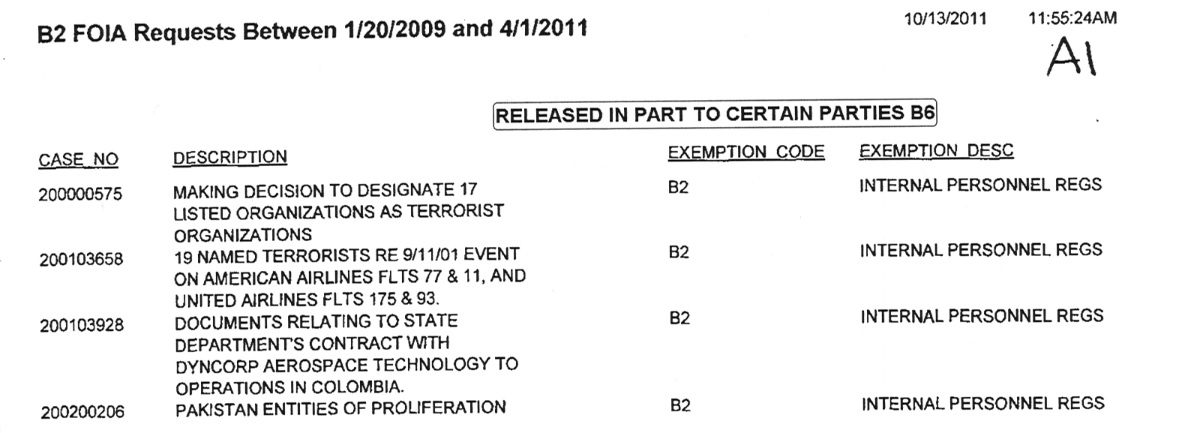
Identifying America’s enemies versus shooting GoDaddy an email: same difference.
What you can do about it: b(2) is rarely invoked by itself, operating more as an “Oh, and another thing …” exemption. If you’re getting denied something, chances are that b(2) isn’t doing the heavy lifting. That said, the language is worryingly vague and does have the potential to be abused by a particularly creative FOIA officer. If that happens, the Reporter’s Committee for the Freedom of the Press has some great resources.
Exemption 3
What it says: “Specifically exempted from disclosure by statute (other than section 552b of this title), provided that such statute (A) requires that the matters be withheld from the public in such a manner as to leave no discretion on issue or (B) establishes particular criteria for withholding or refers to particular types of matters to be withheld.”
What it means: Information that is prohibited from disclosure by another federal law.
What it really means: That.
What you can do about it: Considering that they cared enough about the material to write a specific law exempting it, not a whole lot. But, applying “No Homers” logic here, there might there another way to get what you’re interested in that isn’t part of the exempted material. Time to give your friendly neighborhood FOIA officer a call.
Exemption 4
What it says: “Trade secrets and commercial or financial information obtained from a person and privileged or confidential.”
What it means: Trade secrets and other confidential or privileged commercial or financial information.
What it really means: “The business of America is business.”
What you can do about it: The nice thing about b(4) is that it typically involves corporate lawyers. And while that sounds like the set-up to a joke …
corporate lawyers are refreshingly exact in what they don’t want you to see and why, as well as what recourses you have to challenge them. How novel!
Now, occasionally, you’ll run into an agency deciding on behalf of the company what they’re allowed to give you, in which case you’ll need to call up your new best friend at Weyland-Yutani Legal and let them know the FDA’s doing their job for them. FOIA makes for strange bedfellows.
Exemption 5
What it says: “Inter-agency or intra-agency memorandums or letters that would not be available by law to a party.”
What it means: Inter-agency or intra-agency communications that are protected by legal privileges.
What it really means:
What you can do about it: b(5) is a four-letter word in the FOIA community, with the National Security Archive calling it “the “Withhold It Because You Want To” exemption. In fact, the Federal Electoral Commission once cited b(5) to justify withholding its guidelines for the use of b(5) - only to back down when it turned out it had already posted said guidelines on its website.
Anyhoo: use that arbitrariness to your advantage. Ask the officer to explain why b(5) applies exactly, and then sit back and enjoy the logical contortion act.
Exemption 6
What it says: “Personnel and medical files and similar files, the disclosure of which would constitute a clearly unwarranted invasion of personal privacy.”
What it means: Information involving matters of personal privacy
What it really means: What happens in the surveillance state stays in the surveillance state - a sentiment perhaps best summarized by this FBI file photo:
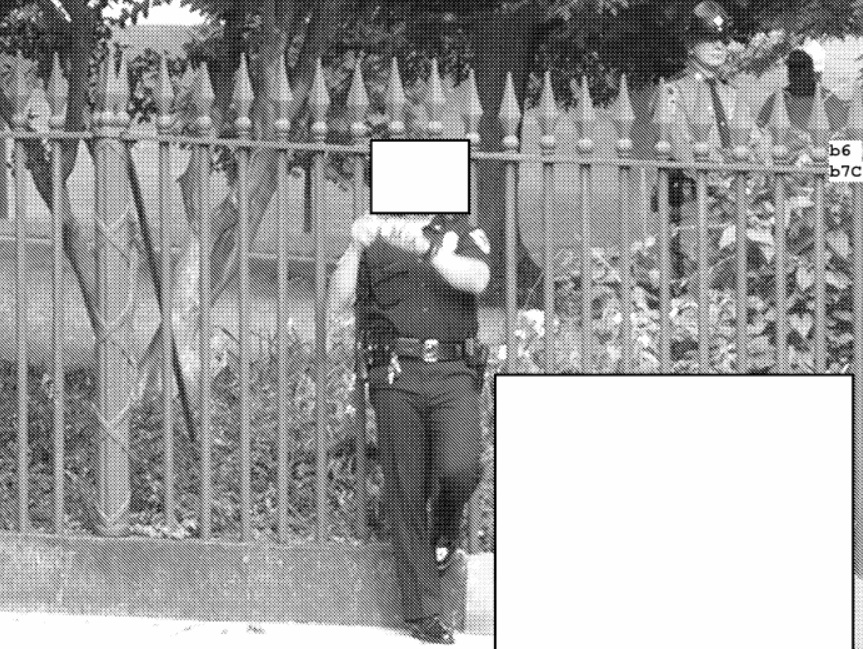
What you can do about it: You can be the person being b(6)’d, you can get permission from the person being b(6)’d, or you can prove the person being b(6)’d is dead and has therefore waived the right to privacy. Although with the latter …
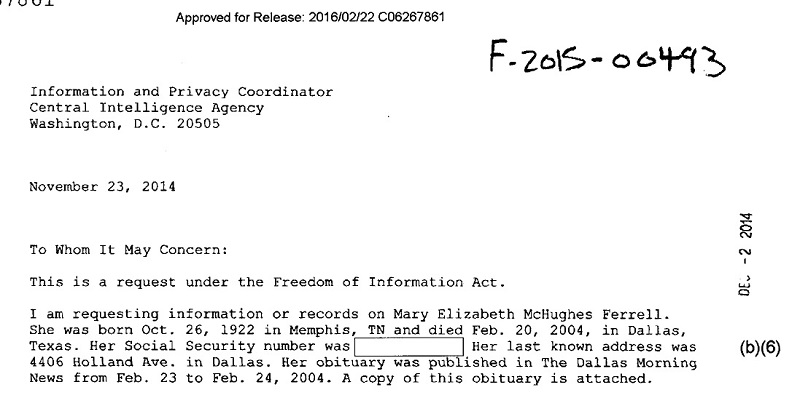
it kinda depends which agency you’re dealing with, and how much they hate you.
Exemption 7
What it says: “Records or information compiled for law enforcement purposes, but only to the extent that the production of such law enforcement records or information:
A. Could reasonably be expected to interfere with enforcement proceedings
B. Would deprive a person of a right to a fair trial or an impartial adjudication
C. Could reasonably be expected to constitute an unwarranted invasion of personal privacy
D. Could reasonably be expected to disclose the identity of confidential source, including a state, local, or foreign agency or authority or any private institution that furnished information on a confidential basis, and, in the case of a record or information compiled by a criminal law enforcement authority in the course of a criminal investigation or by an agency conducting a lawful national security intelligence investigation, information furnished by a confidential source
E. Would disclose techniques and procedures for law enforcement investigations or prosecutions or would disclose guidelines for law enforcement investigations or prosecutions if such disclosure could reasonably be expected to risk circumvention of the law
F. Could reasonably be expected to endanger the life or physical safety or any individual.”
What it means: Records or information compiled for law enforcement purposes, to the extent that the production of those records:
A. Could reasonably be expected to interfere with enforcement proceedings
B. Would deprive a person of a right to a fair trial or an impartial adjudication
C. Could reasonably be expected to constitute an unwarranted invasion of personal privacy
D. Could reasonably be expected to disclose the identity of and/or information provided by a confidential source
E. Would disclose techniques and procedures for law enforcement investigations or prosecutions, or would disclose guidelines for law enforcement investigations or prosecutions
F. Could reasonably be expected to endanger the life or physical safety of any individual
What it really means:
What you can do about it: b(7) and all of its derivatives boil down to some variation of “people will get hurt if we release this information.” In some cases, like ongoing investigations, there’s an argument to be made here (although too often, the “ongoing” part of the investigation is somewhat dubious).
But this becomes problematic when its used as a blanket ward against releasing any details of the agency’s operations, even if it’s ancient history like the services Walt Disney preformed for the FBI …

or more recently, this DEA technique that is supposedly otherwise legally infallible.
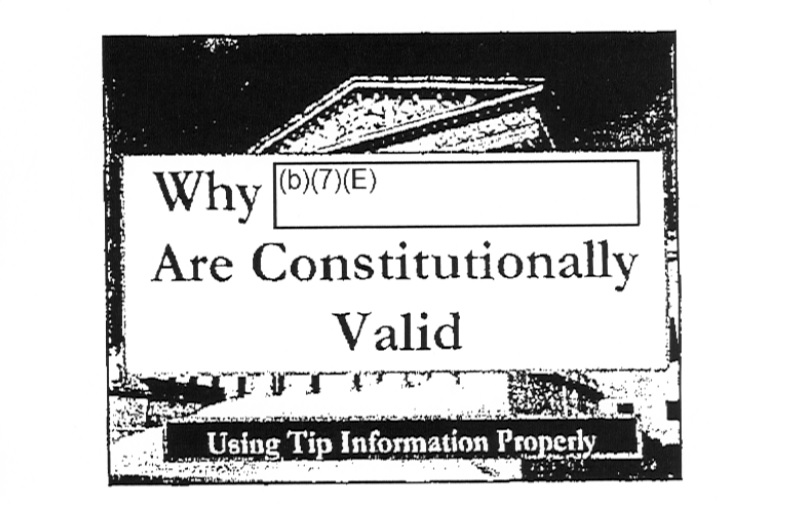
Don’t be afraid to push back - the onus is on them, not you.
Exemption 8
What it says: “Contained in or related to examination, operating, or condition reports prepared by, on behalf of, or for the use of an agency responsible for the regulation or supervision of financial institutions.”
What it means: Information relating to the supervision of financial institutions.
What it really means: “The business of America is still business. Also, why are you asking so many questions?”
What you can do about it: Don’t FOIA the FDIC or Federal Reserve. Or think too much about about looming financial collapse. Go see a movie.
Exemption 9
What it says: “Geological and geophysical information and data, including maps concerning wells.”
What it means: Geological information on wells.
What it really means:
Just kidding - it means geological information on wells.
What you can do about it: You can get that sucker framed. A b(9) is like a prompt full release by the CIA - the stuff of hushed FOIA legend. Way to go, you well-loving weirdo.
Image via Wikimedia Commons




